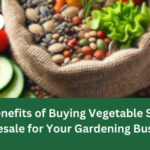Hi there! I’m excited to share with you the benefits and beauty of transforming your front yard into an organic garden.
Organic gardening and eco-friendly landscaping practices are gaining popularity, and for good reasons! Not only do they create a sustainable and environmentally conscious space, but they also add natural beauty to your home.
In this article, I’ll guide you through the principles of eco-conscious gardening, offer tips for planning and maintaining your organic garden front yard, and provide inspiration for showcasing the beauty of natural landscaping.
Key Takeaways:
- Transforming your front yard into an organic garden benefits the environment and creates natural beauty
- Eco-conscious gardening principles include native plants, permaculture design, and sustainable practices
- Planning your front yard garden requires consideration of space, sunlight, soil health, and potential zoning restrictions
- Choosing native plants and implementing permaculture design principles can create a self-sustaining garden ecosystem
- Maintaining your organic garden front yard includes soil health, watering techniques, organic pest control methods, and composting
- Natural landscaping adds aesthetic appeal through texture, color, and diversity
Creating an Eco-Conscious Garden Design
When planning your organic garden front yard, creating an eco-conscious design is essential. Not only does this approach help to protect the environment, but it can also enhance the beauty and functionality of your garden. Here are some principles to keep in mind:
Use Native Plants
One of the keys to an eco-friendly garden design is using native plants whenever possible. These plants have adapted to the local climate and require less maintenance than non-native species. Plus, they provide essential habitats and food sources for local wildlife. For example, in my front yard, I’ve incorporated native wildflowers like purple coneflower and black-eyed Susan.
Implement Permaculture Design
Permaculture design is a holistic approach to gardening that seeks to create a self-sustaining ecosystem. By incorporating principles like diversity, efficiency, and resilience, you can build a garden that requires less maintenance and is better able to withstand environmental challenges.
I use permaculture design in my front yard by using a mix of annual and perennial plants, rotating my crops, and composting.
Reduce Water Use
Another crucial element of an eco-conscious garden design is reducing water use. This can be achieved by using drought-tolerant plants, installing a rainwater harvesting system, and using mulch to retain moisture in the soil. In my front yard, I’ve planted succulents and native grasses that require minimal water.
Avoid Chemicals
Chemical pesticides and fertilizers can be harmful to the soil, plants, and local wildlife. Instead, use natural alternatives like compost, worm castings, and companion planting to promote healthy soil and deter pests. I use a homemade compost tea as a natural fertilizer in my front yard garden.

Remember, an eco-conscious garden design is not only good for the environment, but it can also add value and beauty to your home. By incorporating native plants, permaculture principles, and sustainable practices, you can create a front yard garden that is both stunning and eco-friendly.
Planning Your Organic Garden Front Yard
Planning your organic garden front yard requires careful consideration of several factors to ensure that your garden looks beautiful and functions properly. Here are some ideas to help you get started:
- Assess your available space: Take a good look at the area to determine how much space you have available to work with. Consider the size of your front yard and any potential zoning restrictions that may apply.
- Evaluate sunlight exposure: Observe how much sunlight your front yard receives throughout the day. This information will help you choose plants that thrive in the available light conditions.
- Check your soil health: Test the quality of your soil to determine the type and amount of amendments needed to support healthy plant growth.
- Incorporate edible elements: Consider adding edible plants to your garden design. Not only will this provide fresh produce for cooking, but it will also add visual interest to your front yard.
Once you have evaluated these factors, it’s time to start designing your organic garden front yard. Keep in mind that while aesthetics are important, sustainability should also be a top priority. By using native plants and incorporating permaculture principles, you can create a beautiful and eco-friendly front yard that supports local wildlife and contributes to a healthier planet.

Choosing Native Plants for Your Front Yard Garden
One of the most important aspects of creating an eco-friendly garden design is choosing native plants that are well suited to your local climate. Native plants are those that have evolved to thrive in your area and are able to survive with minimal maintenance. By incorporating native plants into your front yard garden, you can help support local wildlife and conserve resources.
Native plants are typically more resistant to pests and diseases and require less water than non-native species. They also provide a habitat for birds, butterflies, and other pollinators. By creating a diverse landscape of native plants, you can help maintain a healthy ecosystem that supports the local environment.
Examples of Native Plants
Some great examples of native plants that are suitable for front yard gardens include:
| Plant Name | Climate |
|---|---|
| Milkweed | Temperate |
| Purple Coneflower | Temperate |
| Wild Bergamot | Temperate |
| Goldenrod | Temperate |
| Beautyberry | Tropical |
| Firebush | Tropical |
| Palmetto | Subtropical |
| Blue Flag Iris | Subtropical |
When selecting native plants for your front yard garden, consider the amount of sunlight the area receives, the type of soil, and any zoning restrictions that may apply. By carefully planning your garden with native plants, you can create a beautiful, sustainable landscape that supports the local ecosystem.

Implementing Permaculture Design Principles
Permaculture design principles can help create a self-sustaining and eco-friendly garden ecosystem that requires less maintenance and produces more yields.
One of the main principles of permaculture design is diversity. By planting a variety of crops and plants, you can create a garden that can better withstand environmental stresses and provide different types of yields. For example, you can plant fruit trees, vegetables, herbs, and flowers in the same garden.
Efficiency is another important principle. By designing your garden to make the most out of available resources such as sunlight, water, and nutrients, you can minimize waste and maximize output. For instance, you can plant sun-loving crops in areas that receive the most sunlight and shade-tolerant crops in shaded areas.
Resilience is also crucial for a permaculture garden. By creating a healthy garden ecosystem that supports beneficial insects, pollinators, and soil microorganisms, you can reduce the risks of pests and diseases. Additionally, by using organic and sustainable gardening practices, you can avoid polluting the environment with harmful chemicals and synthetic fertilizers.
When designing your organic garden front yard, consider incorporating permaculture principles such as companion planting, intercropping, and mulching. Companion planting involves planting different crops together that complement each other, while intercropping involves planting different crops in the same area to maximize space and yields. Mulching, on the other hand, involves covering the soil with organic materials such as leaves, grass clippings, or compost to improve water retention, suppress weeds, and enrich the soil.

Permaculture design principles can help create a sustainable and abundant garden that benefits both the environment and the gardener.
Maintaining Your Organic Garden Front Yard
Now that you’ve created your beautiful organic garden front yard, it’s important to maintain it properly to ensure its long-term success. Here are some tips and techniques for maintaining your eco-friendly garden:
| Area of Maintenance | Technique |
|---|---|
| Soil Health | Regularly amend your soil with compost or organic fertilizers to maintain nutrient levels and improve soil structure. Avoid using chemical fertilizers which can harm beneficial soil organisms and contribute to water pollution. |
| Watering | Water deeply and infrequently to encourage deep root growth, and avoid watering during the heat of the day to minimize evaporation. Consider installing a rain barrel to collect rainwater for use in your garden. |
| Pest Control | Use natural pest control methods such as companion planting, hand-picking, and soap sprays to avoid harming beneficial insects and pollinators. |
| Composting | Composting is a great way to reduce organic waste and create nutrient-rich soil for your garden. Collect kitchen scraps and yard waste in a compost bin or pile, and add the finished compost to your garden beds. |
Remember to regularly monitor your garden for any issues or changes, and make adjustments as needed. With proper maintenance, your organic garden front yard will continue to thrive and provide a beautiful, sustainable environment for years to come.

Showcasing the Beauty of Natural Landscaping
One of the greatest benefits of creating an organic garden front yard is the natural beauty it provides. Instead of traditional, manicured lawns, natural landscaping can be just as visually appealing while also providing important ecological benefits.
By incorporating native plants, your garden can blend seamlessly into the local environment, attracting local wildlife such as butterflies and birds. Adding a mix of textures and colors can also create visual interest.
For example, I love the look of a mix of tall grasses, wildflowers, and small shrubs in my own front yard.
Additionally, natural landscaping can be low-maintenance, requiring less watering and mowing than traditional lawns. This can save time, money, and reduce the use of harmful chemicals.

Consider incorporating edibles into your garden as well. Not only can they provide fresh produce for your household, but they also add visual interest and can be incorporated into your overall garden design. For example, strawberries can be planted in hanging baskets to add a pop of color to your front porch.
With a little creativity and care, you can create a naturally beautiful front yard that benefits both your home and the environment.
Conclusion
In conclusion, creating an organic garden front yard can have a transformative effect on your home. It not only provides natural beauty but contributes to sustainability efforts through eco-friendly landscaping practices.
By incorporating principles of eco-conscious gardening, planning your garden carefully, choosing native plants, implementing permaculture design, and maintaining your garden regularly, you can create a self-sustaining garden ecosystem that supports local wildlife and requires less maintenance.
Furthermore, natural landscaping can enhance the aesthetic appeal of your front yard, making it eye-catching and unique. It also helps to create a sense of community by showcasing the beauty of nature and encouraging others to embrace sustainable gardening practices as well.
I encourage you to take the opportunity to create an organic garden front yard and enjoy its many benefits. Your home will be transformed into a naturally beautiful and eco-friendly space that supports your well-being while benefiting the environment.



